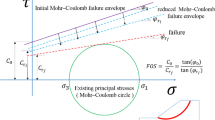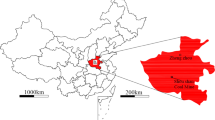Abstract
Mine excavation rate is a fundamental parameter that controls production and efficiency in underground mines. The length of each cycle excavation (LCE) is vital to decrease the cycle numbers and improve the excavation rate. This paper presents a new approach to determine the LCE for the excavation of roadways in coal mines. Initially, a roof stability model of roadway is established using finite difference method (FDM) to obtain the relationship between principal stresses in the roof of the excavation and the LCE. Finally, specific geological conditions are taken into consideration to determine the better suited LCE for a given roadway. The latter assumes a simple beam-problem, in which a beam fixed at two ends and subjected to uniformly distributed loads. The proposed approach thus combines mining stress and geological conditions to provide an indication of an optimal LCE for the roadways under consideration. The results show a safe increase in excavation rate could be achieved by implementing an LCE based on a 6 m advance with temporary support, followed by the installation of the permanent support using rock bolts installed at 0.8 m spacing.









Similar content being viewed by others
Explore related subjects
Discover the latest articles, news and stories from top researchers in related subjects.References
Baudendistel M (1997) Significance of the unsupported span in tunnelling. Tunnelling 85:103–108
Dong R (2015) Mathcad Prime 2.0. Machinery Industry Press, Beijing
Eberhardt E (2001) Numerical modelling of three-dimension stress rotation ahead of an advancing tunnel face. Int J Rock Mech Min Sci 38(4):499–518
Esterhuizen GS, Tulu IB (2016) Analysis of alternatives for using cable bolts as primary support at two low-seam coal mines. Int J Min Sci Tech 26(1):23–30
Exadaktylos G, Stavropoulou M (2002) A closed-form elastic solution for stresses and displacements around tunnels. Int J Rock Mech Min Sci 39:905–916
Guan Z, Deng T, Huang H, Jiang Y (2012) Back analysis technique for mountain tunneling based on the complex variable solution. Int J Rock Mech Min Sci 59:15–21
Guo S-J (2001) Analysis of cycle excavation and productivity of large-scale rock tunnel projects. Can J Civil Eng 28(1):26–34
Hui X, Liu W, Guo F, Hu B, Liu P (2013) Research on the space of the tunnel excavation based on continuous mining construction technology. Coal Eng 22:69–71
Jing L, Hudson JA (2002) Numerical methods in rock mechanics. Int J Rock Mech Min Sci 39(4):409–427
Kang H, Wang J, Gao F (2009) Stress distribution characteristics in rock surrounding heading face and its relationship with supporting. J China Coal Soc 34(12):1585–1593
Lee YZ, Schubert W (2008) Determination of the round length for tunnel excavation in weak rock. Tunn Undergr Space Technol 23(3):221–231
Li CC (2006) Disturbance of mining operations to a deep underground workshop. Tunn Undergr Space Technol 21(1):1–8
Li Q (2013) Strategy of improved mechanized excavation level of Yanzhou Mine Group Company. Coal Mine Mod 12(2):26–27
Li JG, Cao DJ (2007) Optimizing technique for fast driving of fully mechanized drivages. Shanxi Coal 4:24–26
Li H, Yang J, Liu M (2005) Elastic-plastic analysis of beams fixed at two ends subjected to uniformly-distributed loads. J Hohai Univ 33(4):447–451
Lin PH, Tserng HP, Lin CC (2006) Automated construction of the Paghuashan tunnel for Taiwan High Speed Rail (THSR) project. Autom Constr 15(5):627–639
Ma BH (2003) Determination method of reasonable space distance of large section tunnel excavation. Shanxi Sci Tech 5:64–65
Maxfield B (2009) Essential Mathcad for engineering, science, and math, 2nd edn. Academic Press, Cambridge
Obeidat A, Al-Barqawi H, Zayed T, Amer M (2006) Productivity of tunnel construction using road-headers. In: 1st international construction specialty conference, Calgary
Rautenstrauch O, Kulassek M (2014) Equipment for underground roadway drivage: products and engineering from Neuhäuser GmbH. Min Rep 150(4):228–233
Stone R (2016) Design of primary ground support during roadway development using empirical databases. Int J Min Sci Tech 26(1):131–137
Strack O, Verruijt A (2002) A complex variable solution for a deforming buoyant tunnel in a heavy elastic half-plane. Int J Numer Anal Meth 26:1235–1252
Verruijt A (1998) Deformations of an elastic half plane with a circular cavity. Int J Solids Struct 35:2795–2804
Wang JH (2014) China mechanized road header status and bolt support technology in mine seam roadway. Coal Sci Tech 31(1):6–10
Xu ZL (2002) Elastic mechanics. Higher Education Press, Beijing
Xue J, Ni X (2009) Fast excavation technology of fully mechanized driving in coal roadway in Liuzhuang coal mine. Coal Tech 28(10):25–32
Xue Y, Kang T, Huang H (2004) Experimental study on roof structure characteristics and its failure pattern in coal roadway. J China Univ Min Tech 14(1):42–46
Zeng L, Zhu Z, Fu Y (2015) Double meshed stress finite difference method and its applications. Eng Mech 32(1):104–410
Zhao X (2007) Present status and development tendency of high efficient roadway driving technology in coal mine. Coal Sci Tech 35(3):1–10
Acknowledgements
This work is financially supported by Natural Science Foundation of China (51604268 and 51574227), the Fundamental Research Funds for the Central Universities (2014QNB29), PAPD (SZBF2011-6-B35). The authors are also grateful to the coal mine mentioned for providing an experimental environment.
Author information
Authors and Affiliations
Corresponding authors
Additional information
Publisher’s Note
Springer Nature remains neutral with regard to jurisdictional claims in published maps and institutional affiliations.
Rights and permissions
About this article
Cite this article
Yan, S., Wang, R., Bai, J. et al. An alternative approach to determine cycle length of roadway excavation in coal mines. J Ambient Intell Human Comput 11, 553–560 (2020). https://doi.org/10.1007/s12652-018-0987-9
Received:
Accepted:
Published:
Issue Date:
DOI: https://doi.org/10.1007/s12652-018-0987-9




